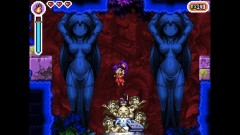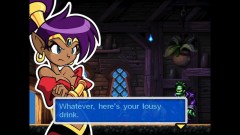Since my last post, I played through two more games to completion. The first one that I finished was Gone Home, which is one of those kinds of games where its best to go in as cold as possible, so I won’t discuss it here other than to say that despite some problems I had getting certain graphics settings (which I know my computer can handle) to run smoothly, it was worth playing. However, I have a lot of opinions about the second game, which I beat yesterday afternoon. Said game is Shantae: Risky’s Revenge – Director’s Cut.
Risky’s Revenge is a Metroidvania platformer, and also a sequel—the original Shantae was a late-in-its-lifecycle Game Boy Color title that is especially prized by collectors. I have never played the latter, and have only been aware of it by reputation and the apparently offbeat, in a good way, title character. A friend gifted me a Steam copy of Risky’s Revenge after seeing it on my wishlist, so I dove into the game expecting a polished platformer with a fun heroine.

Some other parts could’ve done with the same amount of care put into them, though. For starters, there’s Shantae herself. This half-genie, half-human guardian is the grouchiest protagonist I’ve ever encountered in a platformer, especially one so visually appealing. While her pixelated sprite defaults to a bouncy, smiling expression, her three cutscene portraits are neutral, skeptical, and outright surly, and her dialogue often reinforces these visuals. With her personality represented as such, I wondered what her friends thought of her, and didn’t think much of her disagreements with the town’s mayor. Her grouchiness wouldn’t have been a problem if there was something deeper behind it, but there didn’t appear to be anything. In short, at least in this game, she’s not a very good main character, and certainly not one that I’m itching to go adventuring with again.

Sequin Land, the world in which this tale takes place, is just the right size for the game’s scope, though it can be a pain to get around in. The map is crude and difficult to parse at first, and some of the most useful bits of information—such as the locations of previously encountered, unopened treasure chests—are missing altogether. Yes, I realize this was originally a downloadable DSi game, but even by those standards, the map could’ve been much more useful than it was. Getting around this world is done by activating warp statues, which are separate from, and often in different locations than, save points. The main hub is a seaside town (which, inconveniently, does not have a warp point of its own) filled with NPCs; a few of them tell you bits of gameplay info, while the others are there for local flavor and nothing else. The platforming itself is fine, though old fashioned in certain respects; the common technique where one can “fall through” platforms can barely ever be used here. On a similar note, the utilization of items is similarly simplistic; although this is not a problem when it comes to most items, having to de-equip one of the game’s optional-but-useful weapons in the menu, equip one of two different types of potion, go back to the game to use the potion, return to the menu to de-equip it, and re-equip the weapon just to heal up and get right back into battle is more than a little clunky.
I have no problem with games that are true to their roots, and Risky’s Revenge, with its spritework and Game Boy-esque aspect ratio is certainly one such title. However, video games have come a long way over the decades, and the lessons learned by dozens of studios over those years need to be taken into account, not ignored. There are ways to do “fake retrogames” right, such as the cannily-designed likes of Cthulhu Saves the World and Mighty Gunvolt, and then there are those games which choose, however consciously, to keep the warts of the past intact. Shantae: Risky’s Revenge is one such example of the latter, an exercise in selective memory that could’ve really done with a bit more self-awareness and empathy towards the expectations of the present.